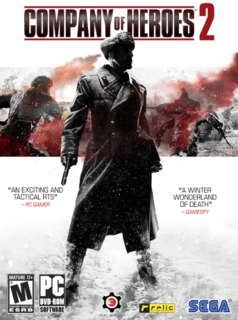INTRO:
The first Company of Heroes was a major coup for Relic Entertainment. Back then, before the first game, there were doubts about whether a competent game with real-time battles in a World War II (WW2) setting could ever be made. That Relic title, with its sharp focus on micromanaging precious units, was well-received.
Relic had learned both good lessons and wrong ones about its successes and made increasingly haphazard choices in its design direction for its later games. This culminated in its acquisition by Sega after its previous owner, THQ, was liquidated. Yet, even with the resources provided by Sega, it still continued its somewhat-muddled designs.
Company of Heroes 2, the sequel, is a consequence of that.
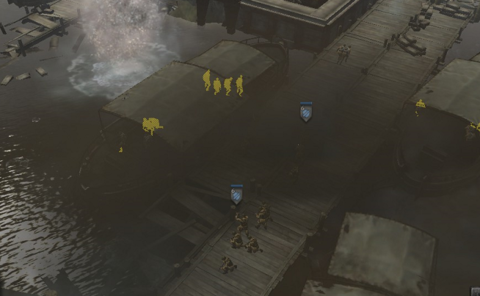
PREMISE:
The game is, of course, still set in WW2 – a setting that has yet to become stale at the time. Since the first game involved the Western European theatre, the main package of Company Heroes 2 would focus on the Eastern European theatre instead, i.e. the war between the Eastern German army and the Red Army.
The main game has a campaign that is based on the events from the near-capture of Moscow by the Germans, then the counter-attack by the Red Army; this is followed by the bloody grind towards Berlin and eventually the fall of East Germany. This is good fodder for an epic tale – though it should be pointed out that Relic has lost its best story-tellers ever since the people that worked on the Homeworld games left.
Relic’s attempt at making an epic tale out of this revolves around an adaptation of the works of a real-life Russian writer, Vasily Grossman. In this adaptation, he is depicted as a former Red Army junior officer that is traumatized by his ordeals. He has been incarcerated, for reasons that will not be clear until much later. (The real Grossman has never been arrested by the way.) He is being questioned by his former superior, who has been called in to assess his loyalty and morals.
CLUMSY STORYTELLING:
Incarceration and reassessment of officers with faltering faith in the Soviet cause is a known thing during the Red Army’s WW2 history. How exactly they happened would be anyone’s guess; first-hand experiences are certainly no longer available by the time of the game. This means that the presentation is up to the writers and directors of the game – and they are clumsy at this work. The following is an example of this clumsiness.
The former junior officer has served under the aforementioned superior officer for some time; the junior officer has even been promoted to the Red Army equivalent of a captain. During that time, the objectives of the missions that the former junior officer undertook are set by the superior officer. Some of these objectives are severe; the junior officer pointed these out, and was dismissed with stern explanations by the senior officer.
Such a storytelling set-up is not unheard of; it is the set-up for the event about the two falling out with each other later, which is indeed what would happen.
However, during the questioning, the senior officer behaves more like a political officer, replete with bombast about glory for Mother Russia at times. There are even a few moments when the senior officer is implied to be unaware about the junior officer’s misgivings, even though the latter has expressed this during the missions.
This example, and some others, give an impression of incongruence between what happens in the cutscenes about the questioning, and the events of the campaign missions. Indeed, the end of the campaign’s story is at its worst, an expression of vacillation.
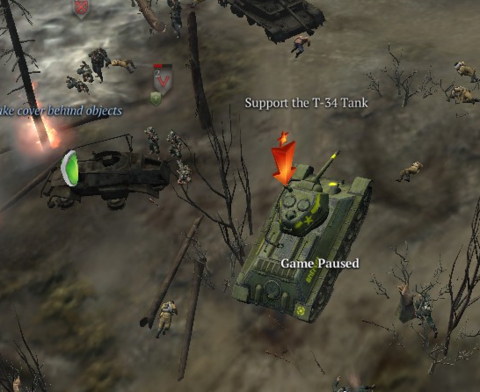
STAPLED-TOGETHER STORY:
Perhaps the most damning indictment of the storytelling is that the former junior officer is not represented in the actual gameplay of the campaign missions. He does not appear as a unit that can be controlled, even though the former junior officer is implied to have been there with his men during the battles. That the former junior officer would later become a war correspondent that is attached with Red Army forces makes his lack of presence even more notable.
Furthermore, the story has been made to somehow glue a bunch of narratively disparate missions together. The moment that is most evident of this slapdash work is when the questioning of video-game Vasily turns to his experience at a Moscow hospital. He was listening to the experiences of a Red Army non-commissioned officer (NCO), at which point the story turns its focus to that NCO’s experience instead and the missions that he was involved in. This will not be the only occasion when this happens either.
Consequently, the player is not really taking on the role of anyone; the player is merely the embodiment of the tactical minds who planned and executed those missions. Granted, of course, the previous game’s story very much has the player being such a being, but at least the previous game’s campaign did not have a weak overarching plot trying to tie them all together.
GAMEPLAY – OVERVIEW:
The unconvincing implementation of story-telling could have been overlooked if the rest of the game has been stellar enough, but this is not the case. There are issues in the gameplay too, mainly due to quirks in the controls and the response of units to control inputs. These will be described later where pertinent.
Otherwise, Company of Heroes 2 has the same gameplay framework as the previous game. The player is expected to focus more on micromanagement, e.g. using the special abilities of units and minding their weaknesses. For ease of focusing on the micromanagement, the macromanagement portion of the gameplay – namely resource management – has been simplified to capturing territories and watching numbers grow.
RESOURCES:
The simplest things about the gameplay would be described first. Like the previous game, there are three resources: Manpower, Munitions and Fuel.
Manpower is the most important, and is also the one that the player would get the most; manpower is needed to requisition reinforcements of almost any kind. Munitions are needed for upgrades and the use of special abilities; these will be very important to the micromanagement-heavy gameplay. Then, there is Fuel, which is needed to field vehicles, most of which are potent and mobile force multipliers.
In other words, there has not been any significant change to the purpose of the resources since the previous game.
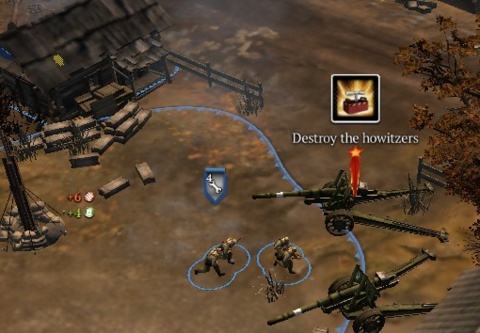
RESOURCES FROM TERRITORIES:
Resources are still obtained in the same manner as they were in the previous game: capturing territories.
However, unlike the previous game, some territories have been divested of association with specific types of resources. Instead, they have tags that indicate the mix of resources that they would yield when they are captured. They can be upgraded into resource caches to improve their resource yields.
Enemies that intend to capture an upgraded territory marker have to destroy the resource caches in order to free up the territory for capture – which can seem silly, considering that they could have captured the posts in their entirety.
Other territory markers are obvious caches of resources that also happen to be indestructible. This was the case too in the first game, and it is still as silly. That said, these markers yield much more resources, albeit these resources are either munitions or fuel, and nothing else.
LIMITS ON RESOURCE LEVELS:
Compared to the previous game, the second game has a few differences in how resources are accumulated for the sake of gameplay balance.
In particular, there are limits on the amounts of resources that can be hoarded; the amounts appear to be stipulated by the conditions of the scenario, as coded by the developers. This means that players that are rolling in resources would not be able to hoard them indefinitely, thus allowing ready replacement of losses.
In multiplayer, this means that players that have gathered much momentum and control a lot of territories must be careful not to take too many losses. The maximum resource levels are often not enough to make up for a major blunder.
MUNITION USAGE:
Munition usage is still a major factor in the balancing of special abilities. In this game, the most tactically valuable special abilities will always have costs in Munitions, but they also have very quick cooldowns – more so than in the first game. Thus, the player can use these special abilities frequently to turn the tide, but at the cost of going dry later.
In multiplayer, observant players would watch how much their opponents use these special abilities, in addition to keeping track of whatever territories that they have gained. This can give an estimate of the amount of munitions that they have left, which will be useful in knowing when to press a seeming advantage and when not to.
MANPOWER UPKEEP:
There is a hidden cost to every unit that the player would field: this is applied as a reduction to the player’s Manpower income. Typically, more powerful units inflict greater reductions.
Manpower income cannot be reduced to negative rates, fortunately. However, this still complicates attempts by players who already have considerable forces from replenishing their forces, especially if they favour the use of infantry.
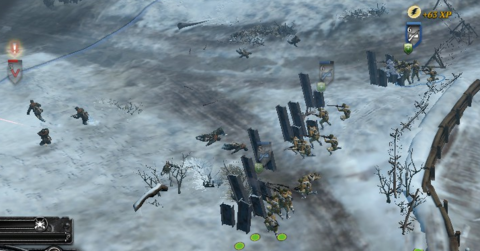
BUILDING BASES AND ARMIES – OVERVIEW:
As mentioned already, Company of Heroes 2 is a micromanagement-focused game; the player will not be raising massive armies and having these flow towards the enemy’s positions. To facilitate this gameplay framework, base building is greatly simplified, as is the matter of bringing in units. Despite the simplicity, both matters are very believable, and one of the two has some nuances.
HOME TERRITORY:
Like the first game, the player gets to have one territory designated as the home base. (Some campaign missions omit this gameplay element, however.)
This territory is usually next to an edge of the map, or is in one of the corners of the map. This is just as well, because the early-match units that the player would requisition would enter the map from that edge. The territory is also easier to defend.
COMMAND POSTS:
The player builds command posts for officers that manage and direct specific war assets. These in turn enable the requisitioning of those war assets. For example, vehicle command posts allow requisitioning of vehicles of specific kinds.
The reinforcements never appear at these buildings. This is unlike typical real-time strategy (RTS) games, but this is much more believable anyway. After all, infantrymen are trained far away from the frontlines, and vehicles are built at factories in the heartlands and shipped to the front. Therefore, the placement of these buildings does not matter much; at most, the player just places the buildings at the rearmost parts of the player’s home territory.
(That statement is only applicable to the Red Army and Wehrmacht East, of course; the factions that are implemented later have different building rules.)
The command posts also make available any army-wide upgrade options, like the option to enable the use of anti-tank grenades for Soviet conscripts. Other than these functions, the command posts do next to nothing else.
BUILDING COMMAND POSTS:
In the base game, the two originally available factions build their bases in similar ways. In particular, their field engineers build entrenched pits in their home territory, which are then converted into their command posts. Other than their WWII aesthetics, these buildings are something that most RTS veterans would be familiar with.
The other factions that will be released for use in non-campaign sessions use different mechanisms for building their bases. These are mentioned in my other articles, if there would be any.
TERRITORY LINKING:
Territories that yield their resources only yield them if there is a contiguous sequence of territories that link back to the home territory. Furthermore, any entry point that the territory has is only usable if the territory is linked to the others. Defences can only be built in linked territories too. Thus, it is possible for enemies to cut off and neutralize a territory by cutting into the territory behind it. However, this will not disable any defences or amenities that have already been invested into that territory, e.g. any bunkers that have been made there are still usable and can be repaired if they are damaged.
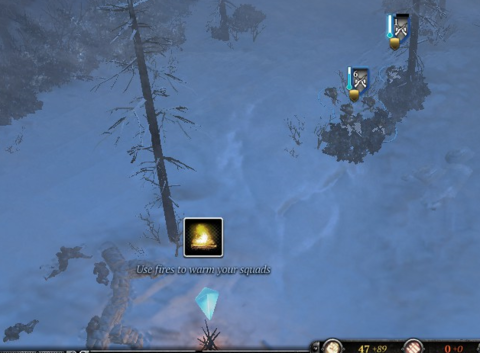
REINFORCEMENTS:
Fresh units are always brought in as reinforcements. This is unlike the previous game, which has field motor shops that build vehicles on the spot from spare parts; that was not believable.
That said, that the sequel brings in new units as reinforcements also meant that the developers saved a lot of effort that would have otherwise gone into building animations. That there are complaints about the development of the sequel being “lazier” is perhaps understandable.
ENTRY POINTS AT EDGES OF MAPS & RALLY POINTS:
Perhaps the most notable improvement that the sequel has over the previous game is the implementation of entry points for territories that border the edges of maps. These territories have ‘X’ markers at the edge of the map that they encompass; these markers are relevant to the requisitioning of reinforcements.
If an ‘X’ marker that is under the player’s control happens to be close to a rally point for a command post, any unit that is requisitioned from the command post will enter the map at the marker. This is very convenient. However, not all maps have these markers, especially the ones that take place on small isles.
ORDNANCE OF THE EASTERN FRONT – OVERVIEW:
The Eastern Front of WWII has been described as particularly devastating in its later stages; when the considerable industry of the USSR gained significant momentum, the Red Army was supplied with hardware that it threw at the Wehrmacht. The Wehrmacht responded in kind, sending its heaviest equipment to the Eastern Front.
Incidentally, some of said German hardware had been seen in the previous game, such as the Panzer IV tanks.
As for the Red Army, their hardware is actually not that much different from the Wehrmacht’s; necessity demands that they use certain similar equipment, namely heavy machineguns and towable anti-tank guns (though they are not as portable as they were in real life; more on this later).
Thus, they are actually not that much different. This is perhaps to be expected, because the setting prevents military forces that are asymmetrical.
NO TOWING:
In real-life, the portable anti-tank guns were towed by attendant lorries and half-tracks, where possible. Towing them across long distances with manpower is foolishly inefficient thing to do, even for the Soviets.
The first game could not implement this; Relic’s programmers could not reach a system that is satisfactory for them. They could not do this for the second game either. However, the excuse that they would give – that the animations for linking the guns looked silly – is not that easy to accept, considering that the game does use silly animations like ragdoll physics (more on this later).
The most notable consequence of this limitation is that howitzers are practically turret emplacements, albeit turrets that have to be rotated by hand. Therefore, the player will have to be doubly sure of where to build howitzers.
Contemporary games like Men of War already have implemented towing for anti-tank guns and artillery. The resulting animations are silly but convenient, and more importantly, allow greater utility for the use of the vehicles that tow them and the portable guns themselves.
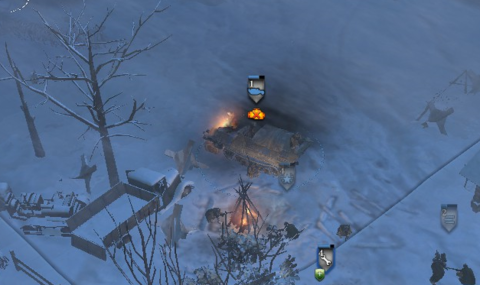
VEHICLE SIDE-GRADES:
As with the field “upgrades” for vehicles in the previous game (and other Relic titles like some of the Dawn of War games), the field upgrades for vehicles in this game are not always straight-up improvements. Rather, some of these make the vehicle better at doing certain things, while reducing or even removing their capability at doing things that they could do before.
For example, the Soviets’ Half-Track Transport was originally intended to ferry around infantry. In certain maps, especially those with territories that do not border the edges of the maps, this capability will be necessary in order to bring fresh troops quickly to the frontline. In maps that have many territories that border the edges of maps, this capability is not so important; thus, the player would want to install an anti-aircraft turret on the vehicle. This removes its transport capability, but turns it into a powerful infantry-killer and, of course, an anti-aircraft platform.
INFANTRY-CARRIED WEAPONS – OVERVIEW:
Understandably, infantry teams carry weapons that they fire on the move, or at least fire after briefly aiming them. Infantry teams are generally issued with whatever weapons that they use as standard, when they enter the map.
However, individuals in infantry teams can also replace their standard-issue weapons with non-standard gear, especially those pilfered from other infantry that has been slain. It does not matter if they have been trained in the use of weapons other than their standard-issued gear; this is not a concern in the gameplay. This was the case in the previous game, and it is even more so in this one.
As fun as this is, the player might not want to get carried away with kitting out infantry teams with stuff. This is because these other weapons are very much side-grades; the infantry gain something in return for giving up something that they had.
UPGRADING:
The first and most readily available option of kitting out an infantry team is using the upgrade options that they have. These become available after the player has built certain command posts or gained enough command points (more on these later).
Of course, these options cost munitions. Losing the individual that has the weapon can be unpleasant, though their comrades will immediately pick these up, if they do not have a special weapon already.
Among these options, the ones that the player will want to consider carefully is anything that gives them anti-tank weapon or a flamethrower. These are weapons that are too heavy to use on the move. In the case of anti-tank weapons, this will reduce their volume of small-arms fire. In the case of flamethrowers, this will reduce their range of engagement; a team with a flamethrower will always try to move into a range at which the flamethrower is usable.
Perhaps the most overt case of give-and-take is the option to convert a standard engineer team into one with mine-detecting gear. The gear prevents them from taking up other equipment and also reduces their damage output.
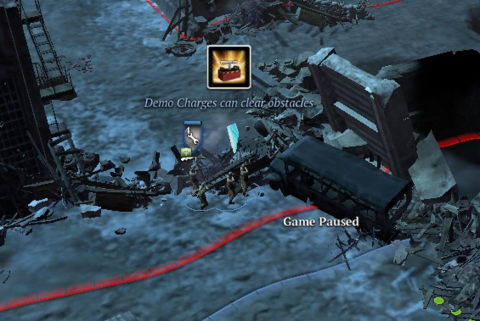
SCAVENGING INFANTRY WEAPONS:
Incidentally, special gear from upgrade options may be dropped by an infantry team after it has been wiped out, or if other members of the team could not pick them up. These weapons are free-for-all; this is always a risk of taking those upgrade options.
That said, an infantry team with members that do not have special weapons can loot these, thus equipping themselves with these weapons. Indeed, it is possible for a team to be kitted out with a submachinegun, light machinegun, a rocket launcher and a flamethrower, resulting in a team that can take on any target, albeit with limited volume of fire.
Alternatively, the player could just have specific teams hog the looting of specific weapons, turning them into specialized teams. For example, a team of Red Army shock troopers – which is initially intended for assault work – can be kitted out entirely with scavenged Panzershrecks. Such massed fire of rockets can knock out most vehicles quite readily, assuming that the team can survive the return fire. However, this team now has next to no capability at dealing with enemy infantry.
REINFORCING:
One of the key designs of the previous game is that infantry teams can have their members replenished when they are near friendly buildings, be they command posts or outposts. Troop transport vehicles also allow them to somehow replenish their ranks, which can seem silly but is otherwise convenient. This design is continued in this sequel.
Thus, infantry-reliant strategies are still very much viable – even essential, especially considering that most vehicles are ponderous compared to infantry.
RETREATING:
Another key feature of infantry is their “retreat” option, though this is much more pared down in the sequel. An infantry team that is ordered to retreat runs away towards the nearest friendly building that they can order replacement members from (this is a key requirement). In the previous game, their retreating speed is prodigious; in the sequel, it is not so. It is possible to gun down the last member of a retreating enemy team.
CANNOT ABANDON SUPPORT WEAPONS:
In the case of machinegun and mortar teams that have been ordered to retreat, the team has to wait for one person to lug their main gear before they can start running. Even so, they run slower than other infantry teams.
In the case of anti-tank guns, their operators cannot be ordered to abandon their portable cannons at all. The player will have to direct them to heave their guns elsewhere. This is silly; in real-life, the crews abandoned their guns, usually after scuttling them.
Perhaps the main issue with this matter is that support weapons that have been crewed do add to the population statistic of the player’s army. Relic does not seem to know how to convert the infantry that is crewing the weapon into other infantry and then dealing with the changes to the population statistic afterwards.
In the Men of War titles, the developers solved this problem by practically having every infantryman somehow capable of using any weapon; thus, every infantryman is practically the same unit as another infantryman. The support weapons themselves do not add to the population statistic. This does pose an issue of gameplay balance and the player has to micromanage their gear, but at least Men of War has more believable implementation of infantry support weapons than Company of Heroes do.
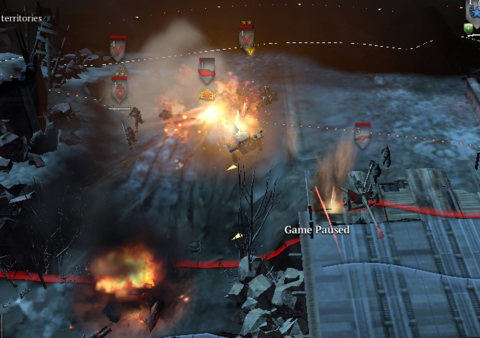
SUPPRESSION:
The gameplay element of infantry suppression returns in the sequel. This is an element that is very necessary for balancing against the advantages that infantry have, namely that they can go places where vehicles cannot.
Certain weapons can inflict suppression. These include machineguns and submachineguns, though the latter apply less suppression. Flak guns can also inflict suppression, though they are more likely to just kill infantry outright.
Infantry that are under suppression have two levels of it. The first, “Suppressed”, slows down their movement and prevents the use of certain abilities (especially the ones that augment their movement). The other level, “Pinned”, is worse: movement is completely disabled and the use of almost every ability is disabled. They are also prevented from firing their weapons. Infantry that are attacked while they are pinned are doomed.
However, friendly infantry that are too close to enemy infantry that are under suppressive fire will be subjected to suppression too, albeit to a lesser degree.
If an infantry team is freed from suppressive fire, their suppression is eventually lifted entirely. “Pinned” infantry teams take longer to be freed. If they are subjected to suppressive fire again before this happens, the countdown resets.
DYING INFANTRY:
Any infantryman who loses all his hitpoints is doomed to die. However, if the killing blow is not something that outright kills him, e.g. obliterates him, he might crawl along the ground in random directions.
This is not just for aesthetics. The dying infantryman does grant vision to his owning player (and his side). This allows the player to call down off-map support on his location, like artillery barrages, if the enemy makes the mistake of lingering around (such as to loot gear or salvage vehicles) and letting him live any longer.
Incidentally, the opposing player can target the dying man for termination – and they should, as unpleasant as this would seem.
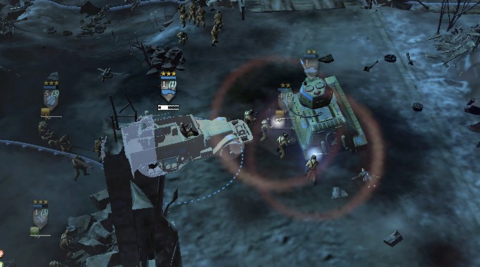
VEHICLE DAMAGE:
Vehicles are essential force multipliers, but they have certain vulnerabilities. Like the first game, the ones in this game are subjected to a system of damage that can diminish their function as they take more damage. In other words, the trope of “critical existence failure” does not apply to them.
However, for better or worse, the system makes use of luck as a factor. When a vehicle takes damage, an RNG roll is made to determine whether it takes a critical hit; this hit does not inflict more damage, but it cripples a component of the vehicle. The threshold for the RNG roll is the percentage of remaining hit points that the vehicle has, so it is more likely to suffer a predicament if it is more damaged.
Then, the game makes another RNG roll, this time to determine what component is knocked out. The probabilities depend on the design of the vehicle and which of its facing is hit. For example, Soviet tanks have their engines at the rear, so understandably, critical hits to the rear are likely to damage their engines.
Usually, suffering a critical hit in the middle of a fight dooms the vehicle. In particular, engine damage renders a vehicle very slow and impossible to withdraw behind other vehicles.
REPAIRING VEHICLE DAMAGE:
Repairing the consequences of a critical hit is not easy. The vehicle’s hitpoints (HPs) will be restored first; damaged components are usually only restored when the vehicle’s HPs are at 100%. It is possible to restore damaged components earlier; some worker units can have the ability to do this. However, this comes at the opportunity cost of not restoring the HPs of the vehicle first.
SALVAGING AND RESTORING VEHICLES:
One of the critical hits that a vehicle can suffer is the loss of its crew. This has the greatest likelihood of happening when a vehicle has already taken a lot of damage and has at least one component knocked out already.
If this happens, the vehicle is rendered vacant. Any player can then send any infantry to crew them; whether they are trained to operate the vehicle or not does not matter. (It should be mentioned here that even Company of Heroes’ contemporary, Men of War, has similar leeway.) Much like unattended infantry support weapons, these vacant vehicles have numbers above them that indicate how many infantrymen is needed to crew them.
On the other hand, the vehicle is likely to be still messed-up. If the enemy attacks it while it has not fully recovered, it will probably be destroyed together with its new crew. Getting it repaired to full functionality is not easy too; getting it to a safe place is difficult. Furthermore, engineers and technicians of a faction are slower at repairing vehicles of other factions.
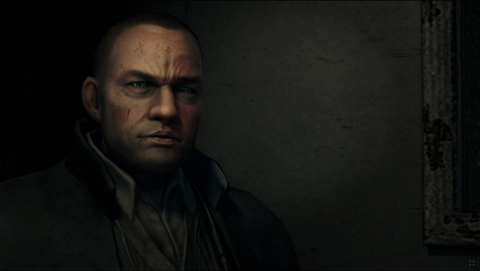
VETERANCY:
Veterancy systems had been in RTS games for a long time, but they are of particular importance to games that focus on micromanagement. Thus, just like the previous game, the second game has such a system too.
Silly numbers and the letters “XP” in golden font appear over units that have earned experience points (XP). Generally, they gain XP from engaging in combat, though there are a few other circumstances that allow for this.
Eventually, having gained enough XP, a unit progresses in its veterancy tracker. The first milestone in the tracker almost always unlocks one of the abilities that is associated with this unit. This ability usually increases the versatility of the unit, which is just as well because the improved versatility may be needed as the battle progresses.
For example, Soviet Conscripts gain the ability to set up trip-wire flares, which reveal enemy units that move across them. Considering that Conscripts are likely to be the most ubiquitous infantry in any Red Army force, having veteran Conscripts use this ability might give the player advance warning on enemy movements, especially in urban environments. Of course, the ability comes with a munitions cost, so the player cannot readily abuse this.
Unfortunately, the later milestones are not as interesting. These grant statistical improvements, more hitpoints being the most common.
Curiously, an infantry team does not lose experience if it takes enough casualties as to be nearly wiped out. Replacement members do not reduce the experience level of the team.
MAP OBJECTS – OVERVIEW:
The map already has things that can be turned to the purpose of war, or otherwise contribute to or hinder the battle in some way. The players can also build things onto the map, other than the command posts that they need to expand their forces.
COVER FROM TERRAIN:
First and foremost of these is the cover that infantrymen would get from pieces of terrain. Thin cover includes hedges and wooden fences that while inadequate against heavy fire, are still better than nothing. Then there are sturdier pieces of cover, such as sandbags and waist-high stone walls. These can eventually be destroyed with explosives and heavy weapons, but until then, they provide good protection from enemy fire that is coming from lateral directions. (This distinction is important.)
Then, there is terrain that actually inflicts a penalty to the defences of infantry that stay in it. These penalties take the form of increased likelihood of being hit by incoming fire, including even from weapons that are generally terrible at dealing with infantry.
Roads are the most notable of this kind of terrain, though roads compensate by improving the movement speed of anyone and anything moving over them. Streams of water are, however, bad for any infantry caught in them while coming under fire; they slow them down in addition to inflicting defensive penalties.
HEIGHT OF COVER:
For better or worse, the game does not always do a good job of informing the player of whether infantrymen can fire over the cover that they are using.
Some pieces of cover indicate this adequately, like walls that are taller than the infantrymen that are using them. In these cases, the infantrymen will not shoot their weapons past the walls at any targets on the other side, unless they have indirect fire ordnance.
The cases where the pieces of cover are just slightly over waist height are a problem, however. There are not many of these in the game, but some maps with villages do have walls that are of these height. Infantrymen perceive these as waist-high walls and will try to shoot over or past them, which sometimes result in their shots landing on those walls instead. This is especially noticeable for machinegun teams.
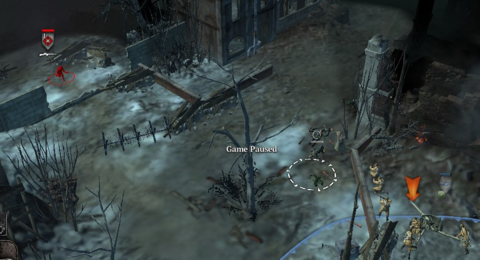
INFANTRY VAULTING OVER WAIST-HIGH COVER:
Infantry can vault over waist-high cover. However, they will not do so automatically if they come across waist-high cover and have to move past them; rather, they attempt to move around it. Vaulting over cover is an order that has to be directly given, apparently by hovering the mouse cursor over the cover and giving the order when the cursor changes shape. This can be tedious.
TREES:
Trees are odd pieces of cover that are particularly prominent in this game; almost every map has them. Trees barely impede infantry movement, and will block the movement of any vehicle except heavy tanks (which crash through them quite readily).
There are copses of trees which are just too dense to crash through. However, heavy ordnance can remove these trees.
DEFENSIVE LINES:
Certain infantrymen can set up defensive lines, though not every type of defensive line is available to every infantry that can set up defences. Some maps have existing defensive lines, but most of them would have to be built and maintained by the players’ units. A convenient line-based control input helps the player builds these across choke points.
Firstly, there are sandbags. These count as good cover for infantry, and are very useful for defending against infantry assaults. They will not help much against suppressive fire and explosives, however. Indeed, explosives scatter the sandbags, rendering them useless.
Secondly, there are razor wire fences. These prevent infantry movement, though they do not give much cover (for good reason). However, enemy engineers and certain infantrymen can cut through razor wire fences and any vehicle can crash through them.
Next, there are tank traps, which prevent the movement of vehicles. Tank traps do not prevent infantry from moving through them; in fact, they provide thin cover to infantry. Tank traps, especially those made from crossing steel beams, are also tall enough to block incoming shots from a lateral direction.
Finally, there are trenches. These cannot be built by any infantry, but can be occupied to gain defensive bonuses and much reduced probabilities of being hit by incoming fire from lateral directions. Trenches also prevent the movement of vehicles. Most importantly, unlike the other defensive lines, trenches cannot be destroyed.
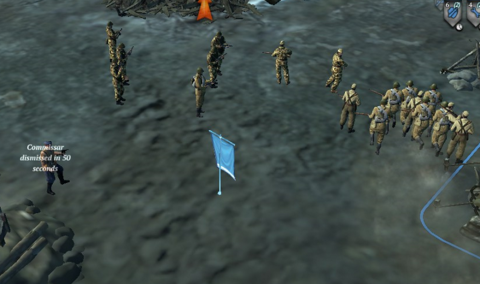
BUILDINGS:
Most maps have civilian buildings in them. Typically, these buildings can be garrisoned by infantry, thus providing them with ready cover and immunity to any suppressive fire. Furthermore, perhaps unbelievably, any building that is occupied cannot be stormed by enemy infantry. Indeed, infantry in buildings are very difficult to remove – unless specific weapons are used.
Firstly, flamethrowers harm infantry in buildings much more readily. Mortar rounds and artillery-grade weapons also smash infantry in buildings, with more of them being killed if the building loses more hitpoints.
Civilian buildings can never be repaired. If they are reduced to ground-level rubble, they also no longer block line of sight.
FORWARD HQ:
Certain civilian buildings can be turned into forward headquarters. Not all buildings can be converted in such a manner, however; there are no clear indicators as to which can be converted. As a general rule of thumb, bigger multi-storey buildings are more likely to be convertible than smaller ones.
Anyway, Forward HQ acts like an entry point and a base building. Fresh infantry units pop out of them when they are requisitioned. Any infantry units that are near them can replenish their numbers. With such advantages, the Forward HQ is balanced by a considerable cost in resources for the conversion. The Forward HQ also cannot be repaired; the player can be certain that enemies that discover them will attempt to bring it down.
BRIDGES:
Some maps feature bridges. Most of these are sturdy enough to allow even the heavy German tanks to move over them.
Yet, most of these bridges happen to be quite destructible. They can be pounded with artillery-grade weapons, or perhaps more efficiently, rigged by engineers with explosives to destroy them. Such a tactic is a double-edged sword, but it may be prudent if the opponent is poised to make an armoured assault across the bridge.
Destroyed bridges can be replaced, albeit the replacement bridge is a mechanical monstrosity that takes a long time to be deployed. Furthermore, the engineers that are doing the replacement are almost always working in areas with cover penalties, e.g. the road just before the bridge or the river bank underneath it. This makes them vulnerable to opportunistic attacks.
REPAIR BAYS AND FIELD HOSPITALS:
Some territories do not yield resources when captured. Rather, they offer amenities to any side that manages to capture them. After capture, support personnel spawn from the outposts under the marker; they will attend to any stricken unit that comes near the outposts. (Comically, the support personnel fall over and die if the territory is relinquished.)
There are repair bays, which as their name suggests, automatically repair any friendly vehicle that happens to trundle into the servicing area of the field facility. The personnel there are limited in number, but they appear to do their repair job significantly faster than engineers and other support personnel.
Then, there are field hospitals. The support personnel at these facilities rush over to any injured infantryman to hand over some medical supplies while also tending to their wounds. The healing rate of these field hospitals is faster than most other sources. The field hospital also allows infantry teams to replenish their members (presumably from previously wounded soldiers that have their fighting ability restored). Repair bays and field hospitals otherwise do not much of anything else.
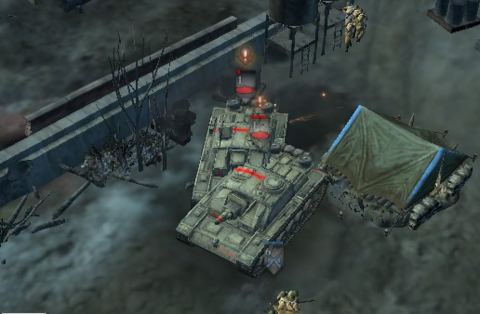
DOCTRINES:
Certain units and upgrade options are not available to a faction by default. These are only accessible to players that adopt certain doctrines.
For example, the Wehrmacht Ostheer (the default German faction) has doctrines that allow the recruitment of Ostruppen, who are Slavic collaborators of the Third Reich. These are very cheap infantry, and are intended to be the German player’s counter to the Red Army’s ubiquitous Conscripts, if the player so chooses.
In non-campaign sessions, the player can choose which doctrine to use, out of the few possible options that the player has set for one’s account. This decision is final, however; the player cannot swap for another doctrine partway through the session.
In the campaign missions, the doctrine of the player’s forces is already chosen for the player. The player is not informed of exactly which doctrine is used, however; the new player would have to learn this by cross-referencing the units that would be available against the documented listing of units for doctrines.
Doctrines also provide a set of off-map support, special requisitions and temporary map-wide benefits. These will have to be unlocked through the accumulation of command points, however.
COMMAND POINTS:
Speaking of which, command points act like experience levels for the player’s forces.
Whenever the player’s forces do anything that contribute to the battle, such as fighting and taking territories, the player generates progress towards gaining command points. This progress is indicated by a dial meter filling up; a full dial grants a Command Point and then resets.
Command points are not spent on anything. Rather, they are functionally experience levels. Upon accumulating a certain number of points, the player unlocks the next special ability that is provided by the player’s chosen doctrine.
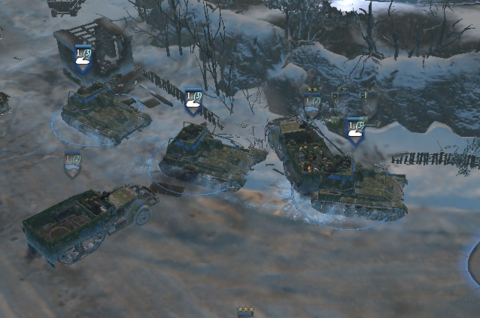
DOCTRINAL ABILITIES:
One of the abilities that are provided by a doctrine is available from the get-go. Usually, this will be the most frequently used ability. For example, one of the Red Army doctrines is about sending in a fresh team of conscripts; this is a staple part of Red Army strategies, due to how useful the Conscripts are.
The other abilities are unlocked as command points are accumulated. These usually complement the first one, but some abilities are not unique to certain doctrines, i.e. these are available to other doctrines too.
The main complication about using doctrinal abilities is that they consume resources to be used. Thus, the player should not be using them willy-nilly (though CPU-controlled opponents sometimes do). Furthermore, doctrinal abilities have considerable cooldowns, so the player would not be able to use them consecutively even if the player has the resources to afford their use.
FOG-OF-WAR LIMITATION ON DOCTRINAL ABILITIES:
Doctrinal abilities generally can only be targeted at spots where the fog-of-war has been lifted. This limitation also applies to off-map artillery support (presumably because it needs spotters in order to be used).
However, this requirement also means that doctrinal abilities can be targeted anywhere as long as the target location has its fog-of-war lifted. Units with indirect attacks or very long range will always reveal their locations when they attack or use their offensive abilities. Thus, these units can be targeted with doctrinal abilities, if the player is quick enough to do so before the fog-of-war descends again.
GROUND ATTACKS:
Cannon-using units can be directed to make ground attacks on specific locations. If there are terrain objects that are at those locations, the units interpret this instruction as the player’s intention to destroy them. This is convenient. However, if they are not directed to stop, they will continue to shoot at that spot.
The only reason to do this is to destroy any tank traps that are in the way, including any that the player has made earlier but no longer wants. However, the weapon that is used must be powerful enough because tank traps have high armor ratings (more on these later).
BARRAGE ABILITIES:
Barrage abilities are usually the purview of units with indirect attacks, especially mortar teams and vehicles. The main reason to use these abilities is that they can be directed at locations with fog-of-war, including even the opaque type.
This is balanced by terrible accuracy; the circle that is drawn around the targeted location indicates the places where the barrages might land. The circle is larger if the location is further away from the unit, though there is a maximum size (in addition to minimum size).
The other balancing measure is that these units cannot be directed to stop their barrages. They keep doing so until they have fired their allotted number of shots, or they are killed. Furthermore, it takes a while for the unit to prep its barrage, so the player will need to be very good at timing them in order to get the most out of them.
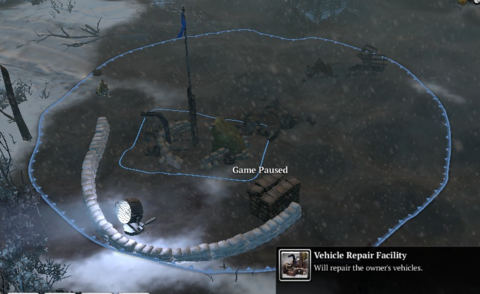
VEHICLES CRASHING THROUGH WALLS AND TREES:
Vehicles can crash through certain things, if they are heavy enough to destroy the latter upon collision. However, players who know about the specifications of WWII war machines and know something about physics will notice that most vehicles are a lot heavier than they should be, with regards to crashing through things.
Indeed, vehicles are not affected much, if at all, when they crash into and through things. They do not take damage and they do not even slow down. This is a noticeable contrast to the contemporaries of this game, such as Men of War.
Anyway, vehicles are given weight ratings, in order to determine how good they are at crashing through things. These weight ratings are not assigned with authenticity in mind, of course.
Firstly, and interestingly, relatively light vehicles such as vehicles that are no bigger than civilian cars are not represented in the base game. Rather, these units are introduced later together with the Oberkommando West and the USA forces. These vehicles, where they do appear, are only able to crash through bushes and wooden fences.
Next, there are vehicles with significant weight. These include the reconnaissance vehicles of the Red Army and the first German faction, and all half-tracks. These can crash through thickets and waist-high stone walls, but not anything else.
Then, there are vehicles that are designated as being heavy; tanks are generally these. These can crash through tall walls, smash through the corners of buildings (thus damaging them) and plough through trees. In the base game, the Red Army’s T-34/76 and T-34/85 tanks are particularly prolific at doing this.
Finally, there are super-heavy vehicles. These include most of the late-game tanks. These can crash through the same things as heavy vehicles, but can also push away the wrecks of vehicles and also damage any enemy that they move through. Indeed, it is possible to tank-shock enemy infantry and vehicles by moving into them, though this is a risky tactic.
However, there does not appear to be any unit that is capable of breaking through tank traps. This is contrast to the first game, in which there are units that can brush them aside.
VEHICLES DESTROYING COVER:
Although some vehicles can readily destroy terrain features to make a path towards the enemy, they also have the tendency to destroy any piece of cover that the infantry that follow in their wake would use.
Indeed, using them for defensive measures is difficult. If the player does not micromanage their movement paths, they can unwittingly destroy any sandbag walls or razor-wire that is intended to stall infantry rushes.
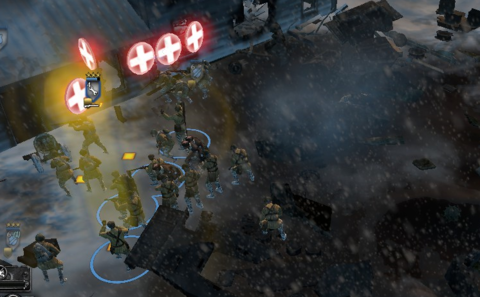
ARMOR AND FACINGS:
Real-time battle games with WWII settings have been featuring the gameplay element about the facings of vehicles and the armor ratings on these. This is in Company of Heroes 2 too. In this game, vehicles have front, side, rear and top facings.
The rear facing usually has the least armor, meaning that any anti-armor attacks are at their most effective when hitting this facing. However, getting around an enemy tank to hit its rear is not easy, especially if it is supported by other units that are there to catch such flanking moves.
The top of a vehicle has little armor too, making them vulnerable to artillery hits. Indeed, late into a battle, howitzers can make short work of tanks if they manage to land their shots.
Most vehicles concentrate their armor in the front facing, though some vehicles have side armor that is almost just as thick (such as the Tiger tank). The only reason to engage the frontal armor of a tank is if the weapon that is used has considerable penetrative power, and such weapons are rare.
Shot angles do not appear to matter in this game, so angling tanks do not seem to do much (unlike how this would in contemporary games like Men of War).
PATHFINDING NOT ALWAYS OPTIMAL:
The game shows the paths that units are expected to take when they are directed to move somewhere. This seems handy, but it also shows how poor their decision-making is.
For one, vehicles will make sharp turns around corners, which are slow to make due to their inertia. Similarly, infantry do not always prioritize sticking close to cover when moving about, which they should.
The worst path-finding occurs when the player tries to have infantrymen move short distances along a piece of cover. Some of the men will get their pathfinding confused; they move around the piece of cover to get to the other end of the cover, instead of taking the shorter path past their own team-mates.
At least there is some good decision-making that has been retained from the previous game. For example, when directed to move to a spot that is close and behind them, vehicles automatically move in reverse instead of making a terribly unwise U-turn.
DEEP SNOW:
Wintry maps have locations with deep snow. The snow slows down units that are moving through it, including even tracked vehicles. They cannot be removed, even though there had been cases in real-life WWII in which tanks armed with dozer-blades could shift the snow away to make a path for convoys.
The snow is a new addition in the sequel, and it is not exactly favoured by every player. For one, the deep snow is near indistinguishable from shallow snow (which has no gameplay significance); only a change in the player’s mouse cursor would indicate this.
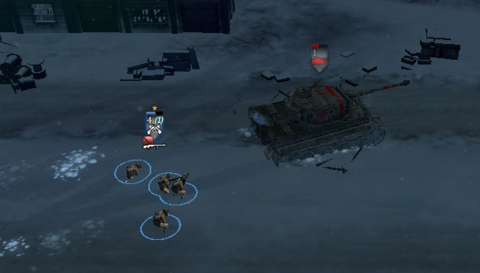
BLIZZARD MAPS:
One of the so-called innovations that the sequel tried to introduce is the implementation of cold and harsh weather. These are the “blizzard” maps, and one of them is featured in the Soviet campaign.
In blizzard maps, there are howling snowy winds that can freeze unprotected infantry; they die within the minute. Infantry can forestall such a demise by huddling around any cover; the cover will not warm them up, however.
To warm up infantry, they need to be around lit campfires, be garrisoning buildings or be in vehicles. This is more unrewarding micromanagement to deal with.
Blizzard maps are also included in the maps for skirmish and multiplayer sessions – but they are deeply unpopular, for very good reasons.
NO PATHFINDING SCRIPTS FOR BLIZZARD MAPS:
The main consternation about blizzard maps is that the units’ pathfinding scripts have not been updated to account for blizzards. This means that the player is forced to dictate the exact paths that infantry would take, in order to minimize exposure.
Although this game is supposed to focus on micromanagement, this is hand-holding of units that most players do not appreciate, especially since it only brings tedium and frustration.
Worst of all, there are infantry units that are immune to the effects of the blizzard, thanks to their higher-quality clothing. In particular, Volksgrenadiers can be upgraded to be immune to the frostbite; this gear of theirs cannot be stolen upon their death.
This gives players with access to such units a major advantage, since they do not have to hold their hands so much.
LINE OF SIGHT:
A much better improvement in gameplay design that the sequel has over the previous game is the implementation of believable line of sight.
In the previous game, units always reveal anything in a radius around them. This is not the case in this game. Indeed, a very tall wall can separate two opposing forces from each other, and they would not be able to see each other. (In such a case, the only hint that the human player would have is the sounds of engines and footsteps.)
Ruined buildings produce the most line-of-sight determination. The broken pillars and stubs will hinder line of sight. Thus, the ruins of buildings are difficult to defend or attack without infantry that have been kitted out with submachineguns.
CPU-controlled forces do not have to worry about line of sight, of course. Indeed, they seem to have the advantage of knowing exactly where the player’s forces are (though they actually do need this advantage, because they are quite incompetent).
LINE OF FIRE:
Projectiles have to follow spatial physics in this game, including being blocked by any hitboxes that are in between the shooter and the target. This has consequences on the reliability of a shot hitting the target.
For example, infantry-operated heavy machineguns are often deployed at knee-height and waist-height. This means that if there is waist-high cover in between the machinegun and the target and the machinegun is not immediately adjacent to the cover, some of the shots from the machinegun will hit the cover and be wasted.
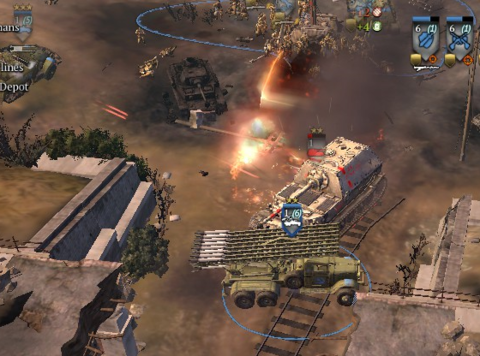
PROGRESSION SYSTEM FOR MULTIPLAYER:
For better or worse, there is a progression system for the multiplayer component of the game. This system includes the options of doctrines that the player can pick from during a multiplayer session. It also includes specific units and upgrade options that are made available to the player during that session, if the player so chooses to bring them into the session.
This progression system grants experience points to the player’s account after the player has completed a multiplayer match – specifically a match that is set up by Relic’s multiplayer infrastructure. Gaining experience points and eventually levels unlocks more options for units and upgrade options.
The player cannot bring all of the unlocked stuff into the next session; this is the main gameplay-balancing limitation of multiplayer. The player can only bring a specific mix of these things, preferably a mix that fits the player’s playstyle. There is no way to know what opponents and allies would bring into play, unless the player has been informed about them beforehand.
This is a system that was not in the previous game; consequently, the previous game’s multiplayer experience would eventually turn stale for anyone given enough time. This system in the sequel does foster enough unpredictability in matches such that the onset of staleness is stalled.
However, it also poses the risk of perceived gameplay imbalance. For example, a competent player could achieve a potent mix that is difficult to counter without a mix that is intended to do exactly that. Indeed, every time this happens, there would be forum threads complaining about it.
VISUAL DESIGNS:
Company of Heroes 2 can be a pretty game, if the player has a machine that can apply all of the textures and shadowing that has been implemented in the game’s code at this time of writing. At the best settings, objects can break apart into gratuitous bits when hit with heavy ordnance and smoke and steam can be seen emanating from guns, to cite some examples of graphical detail.
The game does scale well to lesser machines, fortunately. The Steam version of the game will at least pick a tier of settings that is intended for optimal performance on the player’s computer, assuming that it can run the game.
However, as much pizzazz as the player could eke out of the game, there are some notable visual designs that Relic has implemented to keep things simple. In particular, objects that no longer matter to the gameplay are given ragdoll physics. This is most noticeable when moving vehicles brush aside infantrymen that have died.
As with the previous game, the models for the units and environs are the highlights of the visual designs. On the other hand, there have been many, many games with WWII settings, so any attention to detail that Relic’s artists and animators have given to their visual assets are no longer as awe-inspiring as they were in the previous game.
In other words, Company of Heroes 2 may offer an amusingly brutal visual rendition of the violence in WWII, but so has many other games. It reaches the bar of standards, but does not raise it.
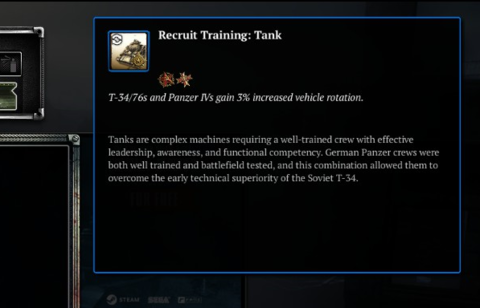
SOUND DESIGNS:
Sombre music is the first thing that the player hears from the game (after having gone past the usual splash intros, including Sega’s). This is perhaps in line with Relic’s attempts at showing the bleakness of the last years of WWII, specifically the wintry parts of the European theatre. Of course, there are tracks with more urgency, such as those that play during the more dramatic campaign missions.
The highlights of the sound designs are of course the sounds of battle. In this regard, Relic perhaps has benefited from the patronage of Sega, presuming that Sega has provided Relic with contacts from which it can source audio assets from.
Granted, only aficionados of WWII weaponry or survivors of WWII (as few as they are by this time of writing) can confirm how authentic they are. The authenticity of small-arms fire are perhaps easier to verify, but the sounds of heavy ordnance, especially the cannons of the tanks, would be more difficult to examine beyond comparing them with the recordings on preserved WWII films.
Perhaps the most disappointing sound designs are the voice-overs. It is obvious that Relic could not find enough native speakers for the voice-overs of units and characters who are not of British or American nationality. For example, the Polish partisans that can be fielded by Red Army forces with doctrines of cooperation with resistance forces slip into British accents occasionally. The worst examples are, unfortunately, the voice-overs for the characters in the base-game campaign.
SUMMARY:
Company of Heroes 2 retains all the good things about the previous game: strong focus on micromanagement, intense battles and reward for cunning tactics. However, it has few actual improvements over the first game, beyond what has been provided by technological advances in game engines. Indeed, the introduction of the Soviets could have been implemented as another DLC package for the first game.
If viewed from a cynical perspective, the second game is little more than a content expansion of the first game, and some balance tweaks for how the gameplay handles resource incomes. All of the additional things – especially the progression system for its multiplayer games – that the sequel has over the previous game do not build on the main appeals of the franchise.
Perhaps the most important criticism is that the Company of Heroes is no longer the only major player in its niche by the time of the second game. Contemporary series, like Men of War, Sudden Strike and Steel Division, can do what Relic’s titles do, and in some aspects (such as towing anti-tank guns) do better too.
